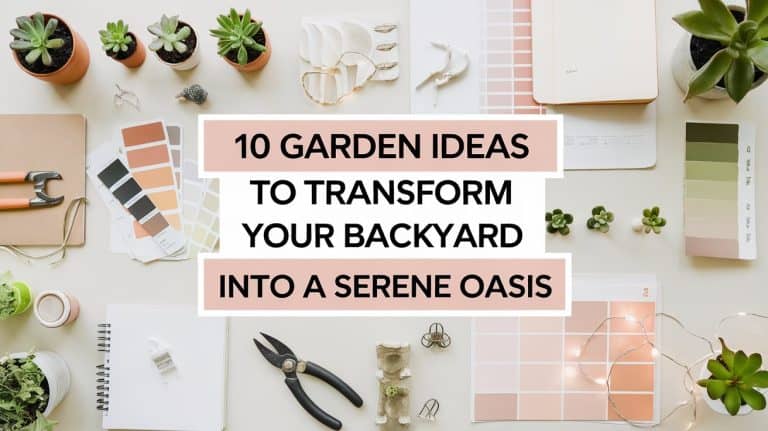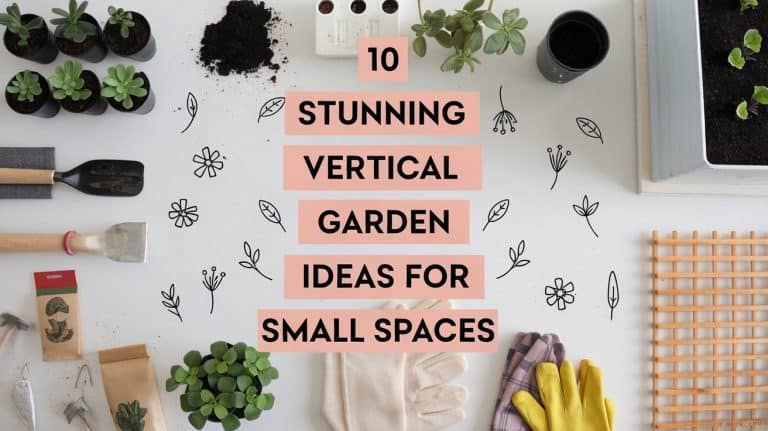This website contains affiliate links. Some products are gifted by the brand to test. As an Amazon Associate, I earn from qualifying purchases. The content on this website was created with the help of AI.
You’ll create a thriving butterfly garden by focusing on four proven plants: Purple Coneflower, Butterfly Bush, Black-Eyed Susan, and Lantana. Each offers unique benefits – Purple Coneflower attracts Monarchs and thrives in zones 3-9, Butterfly Bush provides continuous blooms from summer to fall, Black-Eyed Susan draws smaller butterfly species, and Lantana serves as both nectar source and host plant. Plant these in well-draining soil with 6-8 hours of daily sunlight, spacing them 18-24 inches apart in clusters. While these plants form your garden’s foundation, understanding proper design and maintenance techniques will maximize your garden’s butterfly-attracting potential.
Key Takeaways
- Purple Coneflower attracts Monarchs and Painted Ladies while being drought-tolerant and easy to maintain in most U.S. growing zones.
- Butterfly Bush provides continuous blooms from summer to fall and requires minimal care while attracting numerous butterfly species.
- Black-Eyed Susan offers reliable summer-long blooming and attracts butterflies with its bright flowers and simple growing requirements.
- Lantana thrives in warm climates and produces colorful flower clusters that attract both butterflies and moths throughout the season.
- Plant these butterfly-attracting species in clusters 18-24 inches apart in full sun locations for optimal butterfly visibility and activity.
Why Create a Butterfly Garden
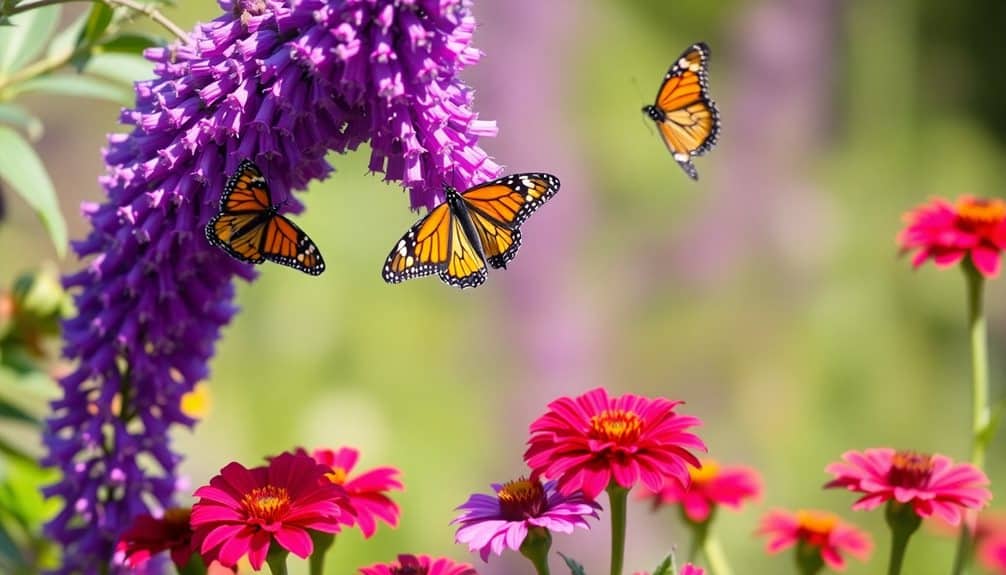
Creating a butterfly garden stands out as one of the most rewarding ways to support local ecosystems while enhancing your outdoor space. You’ll provide essential habitat for native butterfly species while establishing a sustainable environment that supports their complete life cycle, from egg to adult. These gardens serve as significant waypoints for migrating species like Monarchs, offering them necessary resources during their long journeys.
Your butterfly garden will contribute to pollination networks in your local area, as butterflies rank among nature’s most efficient pollinators. They’ll help maintain genetic diversity in plant populations while supporting fruit and seed production. You’re also creating a living laboratory where you can observe butterfly behavior, document species variations, and track seasonal patterns.
Beyond environmental benefits, you’ll establish a dynamic outdoor space that changes throughout the growing season. The diverse plant selection required for a successful butterfly garden guarantees continuous blooms, varying foliage textures, and year-round visual interest. You’ll also attract other beneficial insects and birds, creating a balanced ecosystem that reduces the need for pesticides and artificial interventions in your garden.
Essential Butterfly Garden Design Tips

How you arrange your butterfly garden can make the difference between occasional visitors and a thriving habitat. You’ll need to create distinct zones that serve specific purposes: nectar sources, host plants, sunbathing spots, and protective shelter.
Position your garden in a location that receives 6-8 hours of direct sunlight daily, as butterflies require warmth for flight. Install flat rocks or garden ornaments in sunny spots to provide basking areas where butterflies can regulate their body temperature. Create windbreaks using tall shrubs or decorative screens to protect these delicate insects from strong gusts.
Arrange plants in clusters rather than single specimens, as masses of color are more attractive to butterflies. Position taller plants at the back of borders and shorter ones in front, guaranteeing easy access to nectar sources. Include a shallow water source with pebbles or sand where butterflies can safely drink and obtain minerals.
Don’t forget to incorporate host plants for caterpillars in less visible areas of your garden. This guarantees that butterflies will complete their entire life cycle in your space, establishing a sustainable population.
Purple Coneflower
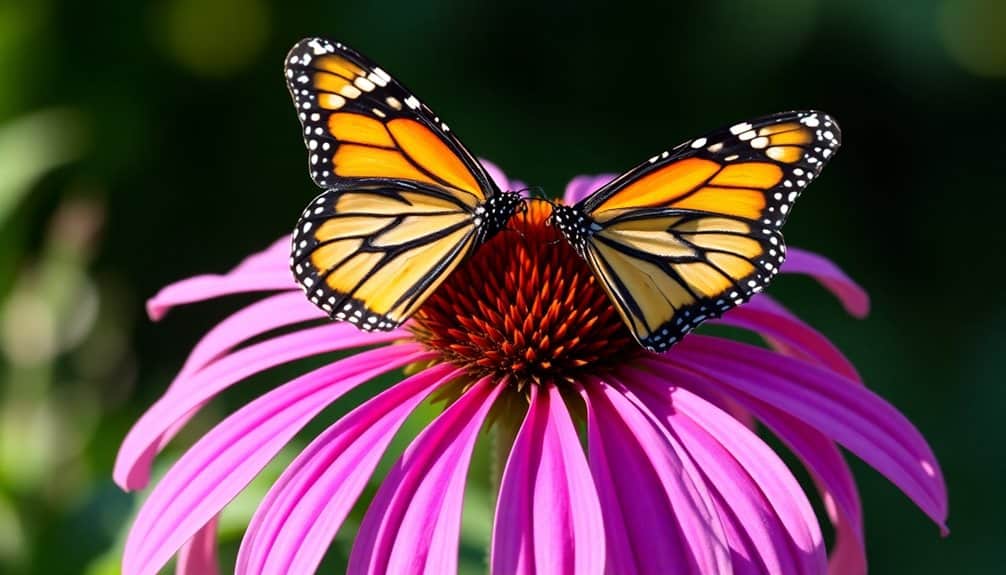
Among the most reliable butterfly-attracting perennials, Purple Coneflower (Echinacea purpurea) stands as a cornerstone species for any starter garden. You’ll find this native North American plant blooming from mid-summer through fall, producing large, daisy-like flowers with distinctive cone-shaped centers and drooping purple petals. Its sturdy stems reach heights of 2-4 feet, making it an excellent mid-border placement option.
You won’t need to fuss much with Purple Coneflower, as it’s significantly drought-tolerant once established and thrives in USDA zones 3-9. Plant it in well-draining soil where it’ll receive 6-8 hours of full sun daily. While it prefers neutral to slightly acidic soil (pH 6.0-7.0), it’ll adapt to most soil conditions.
The plant’s nectar-rich blooms attract numerous butterfly species, including Monarchs, Painted Ladies, and Swallowtails. You’ll also notice that its seed heads provide essential food for goldfinches during fall and winter. For ideal butterfly attraction, plant Purple Coneflower in groups of three or more, spacing them 18-24 inches apart. Deadhead spent blooms to extend the flowering period, but leave late-season seedheads intact for winter interest.
Butterfly Bush
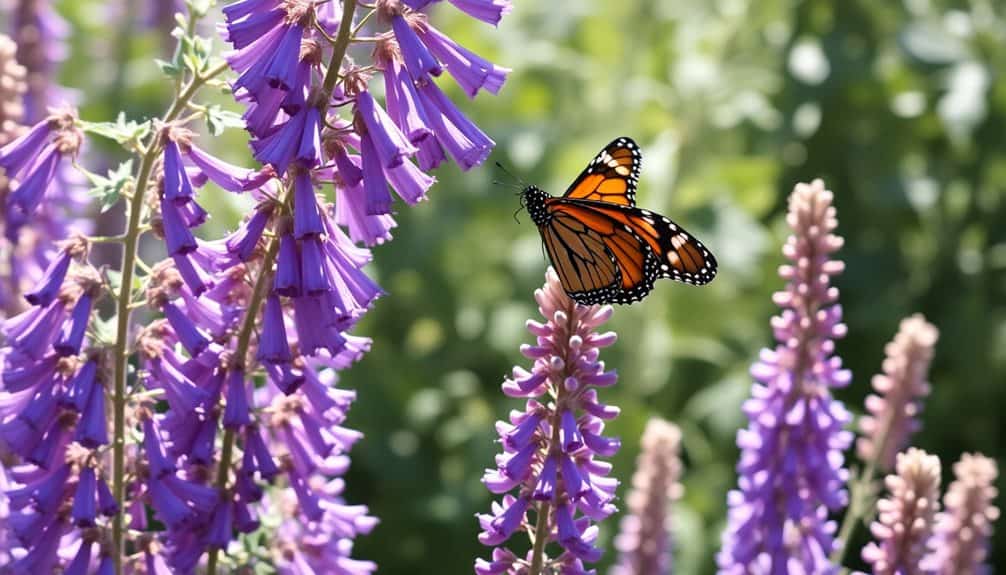
Despite its somewhat controversial nature as a non-native species, Butterfly Bush (Buddleja davidii) delivers an impressive display of long-lasting, fragrant flower spikes that’ll captivate both butterflies and gardeners alike.
You’ll find this fast-growing shrub reaches heights of 6-12 feet if left unpruned, though you can easily maintain it at 4-5 feet through regular trimming. For ideal butterfly attraction, plant your Butterfly Bush in full sun with well-draining soil. It’s remarkably drought-tolerant once established and will bloom continuously from summer through fall if you deadhead spent flowers.
When adding this powerhouse pollinator plant to your garden, expect to witness:
- Clusters of tiny, tubular flowers in shades of purple, pink, white, or blue, forming dense cone-shaped panicles up to 12 inches long
- Dozens of butterflies feeding simultaneously on a single bush during peak bloom periods
- Constant activity from beneficial pollinators, including hummingbirds and bees, drawn to its rich nectar content
In zones 5-9, you’ll get reliable performance from this hardy shrub, though in colder regions it may die back to the ground in winter before resprouting in spring.
Black-Eyed Susan
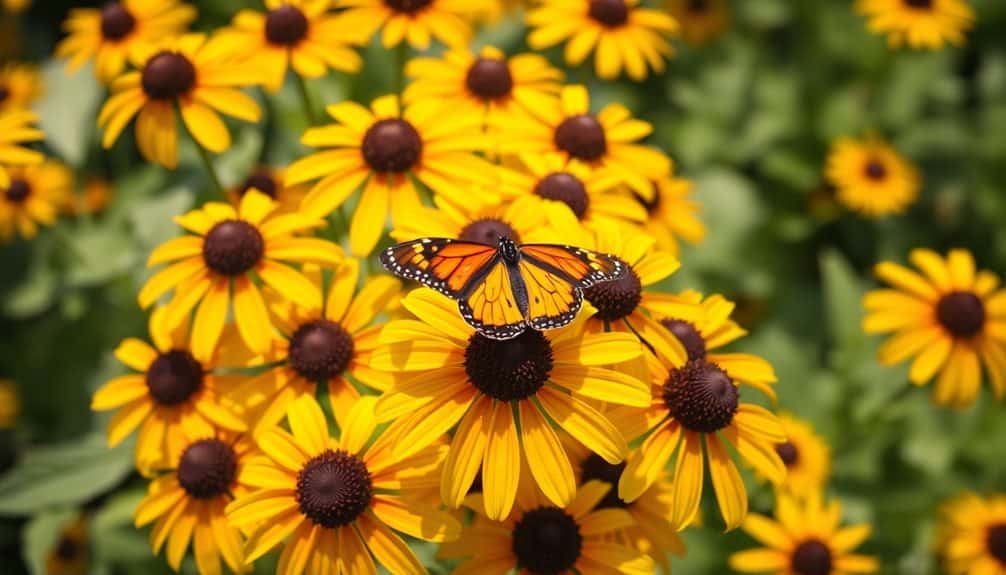
While Butterfly Bush offers towering blooms, Black-Eyed Susan (Rudbeckia hirta) brings its golden charm closer to ground level. This native North American perennial typically grows 2-3 feet tall and produces striking daisy-like flowers with dark brown centers surrounded by bright yellow petals. You’ll find it’s one of the most reliable butterfly attractors, particularly for smaller species like Pearl Crescents and Painted Ladies.
Black-Eyed Susan thrives in USDA zones 3-9 and prefers full sun, though it’ll tolerate partial shade. You’ll want to plant it in well-draining soil, spacing plants 18 inches apart. It’s drought-tolerant once established and doesn’t require frequent fertilization. The blooming period extends from June through September, and you can extend it by deadheading spent flowers.
For butterfly gardening success, plant Black-Eyed Susan in clusters of at least three plants. This creates a more visible landing pad for butterflies and enhances the garden’s visual impact. The plant’s sturdy stems serve as perfect perches for butterflies to rest and feed, while its nectar-rich flowers provide essential sustenance throughout the growing season. Adding soil amendments before planting will ensure optimal growth and flowering performance.
Lantana
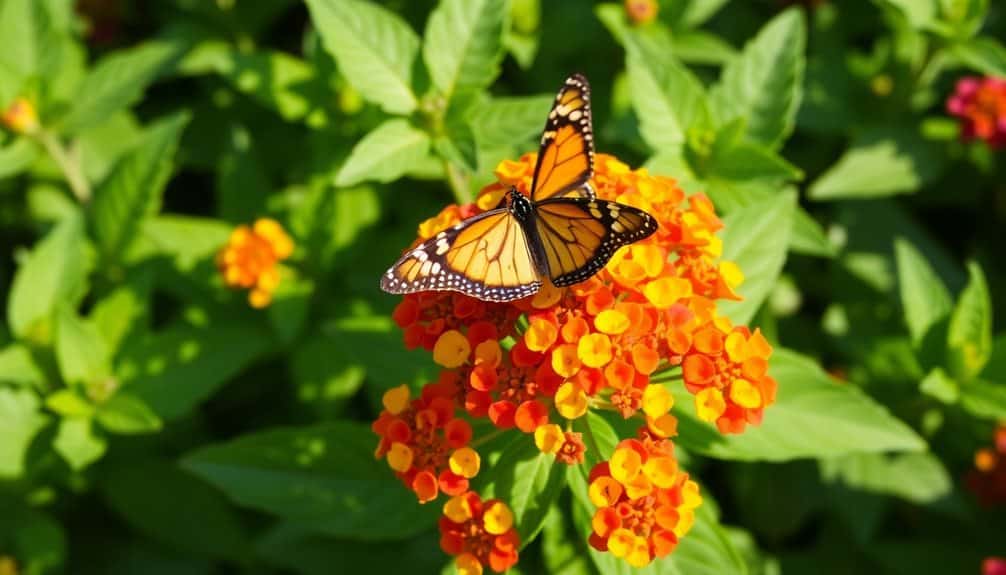
Looking to add a burst of color that butterflies can’t resist? Lantana’s clusters of tiny, tubular flowers bloom in vibrant combinations of yellow, orange, red, pink, and purple. This heat-loving perennial thrives in USDA zones 8-11 and serves as both a nectar source for butterflies and a host plant for some species of moths.
You’ll find that lantana’s aromatic foliage and drought tolerance make it an excellent choice for sunny garden spots. Plant it in well-draining soil and provide adequate spacing, as mature plants can spread 3-6 feet wide. Once established, lantana requires minimal maintenance and blooms continuously from spring until frost.
Here’s what makes lantana a butterfly magnet:
- Multi-colored flower clusters change hues as they age, creating a kaleidoscope effect that attracts various butterfly species
- Long-lasting blooms provide consistent nectar sources throughout the growing season
- Flat-topped flower clusters offer perfect landing pads for larger butterflies like monarchs and swallowtails
If you’re growing lantana in colder regions, treat it as an annual or overwinter it indoors. Prune regularly to encourage bushier growth and more abundant blooms.
Planting and Maintenance Guide
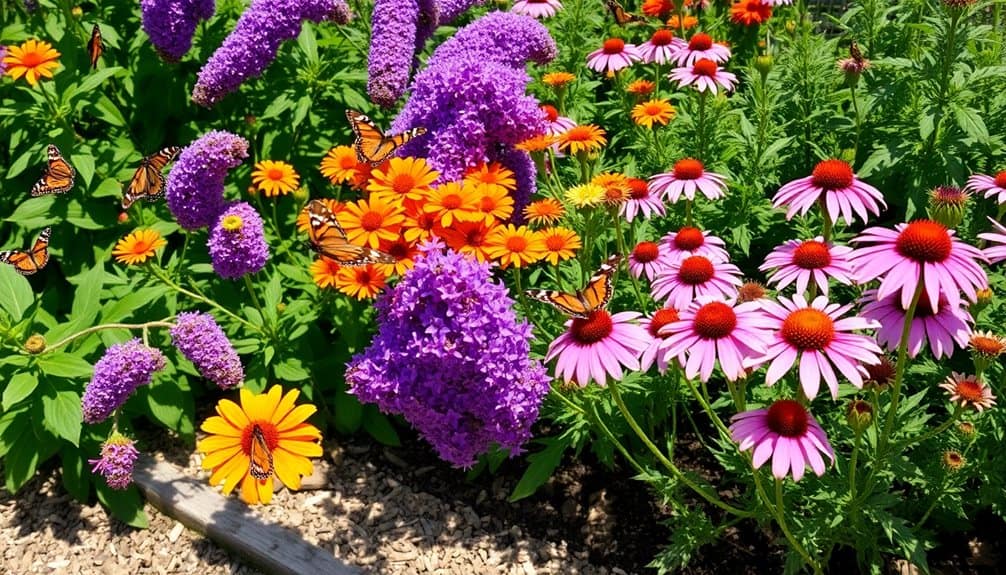
Now that you’ve selected beautiful butterfly-attracting plants like lantana, proper planting and maintenance techniques will guarantee your garden’s success. Start by selecting a location that receives 6-8 hours of direct sunlight daily. You’ll want to prepare your soil by incorporating organic matter and ensuring proper drainage.
Space your plants according to their mature size requirements, typically 18-24 inches apart for most butterfly-attracting perennials. When planting, dig holes twice the width of the root ball and position plants at the same depth they were growing in their containers. Water thoroughly after planting and add 2-3 inches of mulch around plants, keeping it away from stems.
Maintain your butterfly garden by deadheading spent blooms regularly to encourage continuous flowering. You’ll need to water deeply once or twice weekly, depending on rainfall, focusing on the root zone. Apply a balanced, slow-release fertilizer in spring and mid-summer. In fall, cut back perennials to 6 inches above ground level. Don’t use pesticides in your butterfly garden, as they’ll harm both caterpillars and adult butterflies. Instead, hand-pick harmful insects or use organic controls when necessary. For optimal plant health and longevity, conduct regular inspections every six months to identify any signs of wear or disease.
Common Butterfly Garden Mistakes
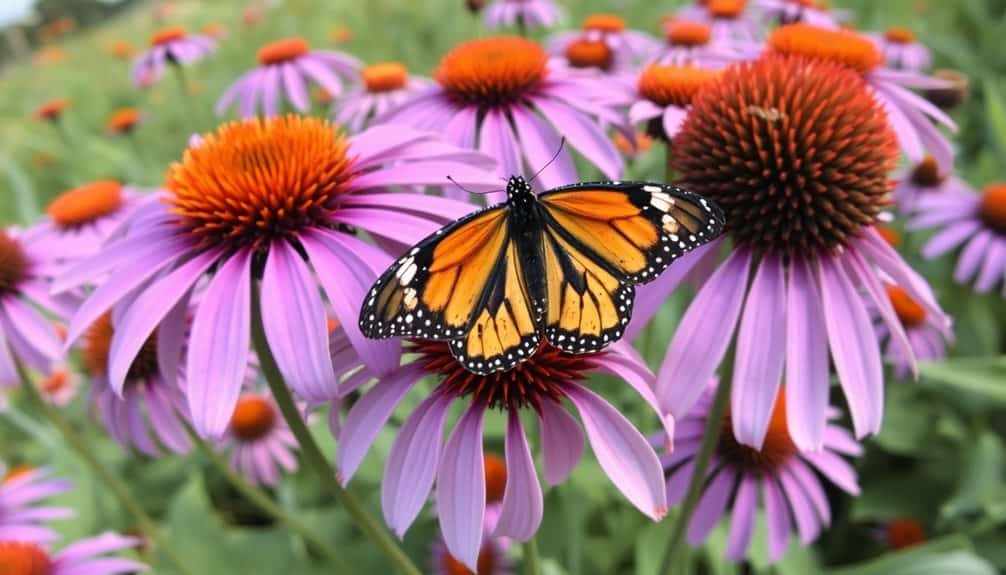
Three critical mistakes can derail even the most well-intentioned butterfly garden. First, you’ll sabotage your garden’s success if you’re using pesticides, even organic ones, as they don’t discriminate between harmful insects and beneficial pollinators. Second, placing your butterfly-attracting plants in heavily shaded areas will greatly reduce their nectar production and overall attractiveness to butterflies. Third, focusing solely on adult butterfly needs while neglecting caterpillar host plants will break the lifecycle support your garden should provide.
Beyond these major pitfalls, there are specific design mistakes you’ll want to avoid:
- Scattering individual plants too far apart instead of clustering them in groups of 3-5, which makes them harder for butterflies to locate from above
- Installing butterfly houses or other artificial structures that don’t actually attract butterflies and waste valuable garden space
- Choosing exotic butterfly bush varieties that can become invasive instead of native alternatives that provide better ecological support
Seasonal Care Tips
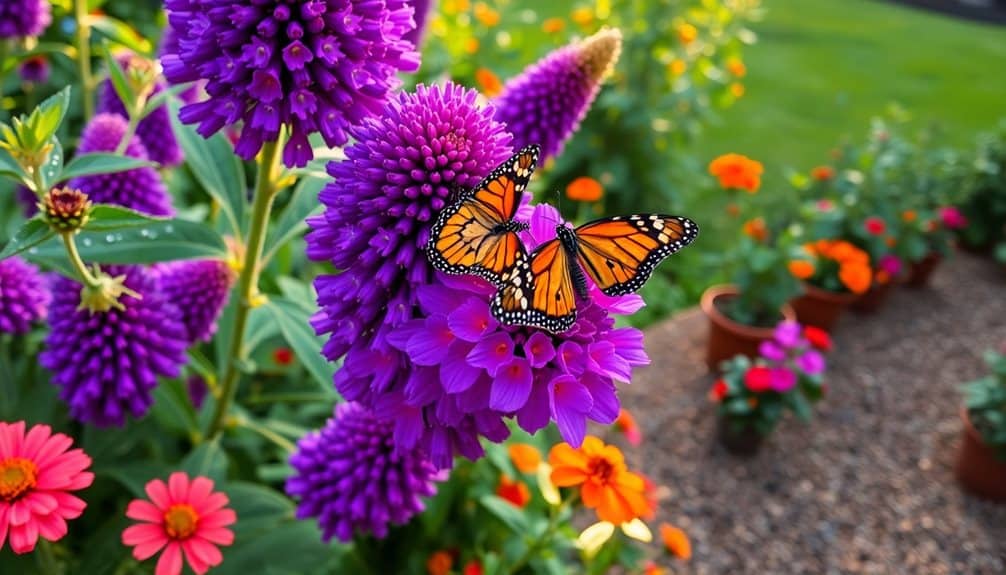
Successful butterfly gardening requires specific maintenance adjustments throughout the year to maximize your garden’s appeal to pollinators. During spring, you’ll need to prune back dead growth, divide overcrowded perennials, and apply a slow-release organic fertilizer. It’s also vital to monitor emerging plants for pest damage while avoiding pesticide use.
Summer maintenance focuses on deadheading spent blooms to encourage continuous flowering and maintaining consistent soil moisture through mulching and targeted watering. You’ll want to remove any diseased foliage promptly to prevent spread.
As autumn approaches, resist the urge to cut back all dying plants immediately. Leave seed heads and stalks intact, as they provide essential winter shelter for butterfly eggs and chrysalises. Consider adding late-blooming nectar plants to support migrating butterflies.
Winter preparation involves adding a thick layer of mulch around plant bases while maintaining some bare soil patches for pudding sites. You’ll need to protect tender perennials with frost covers during severe cold snaps. Document which plants performed well throughout the seasons to refine next year’s planting strategy and butterfly attraction success.
Frequently Asked Questions
How Long Does It Take for Butterflies to Find a New Garden?
You’ll typically see butterflies discovering your new garden within 2-4 weeks after planting nectar-rich flowers. They’re excellent at detecting floral scents from up to a mile away and use visual cues to locate food sources. If you’ve planted native species and provided essential host plants, you’ll attract local butterfly species faster than if you’re only offering nectar plants.
Can Butterfly Gardens Attract Unwanted Insects or Pests?
Like a buffet for all winged diners, your butterfly garden will attract various insects beyond butterflies. You’ll likely see bees, moths, and beneficial predatory insects like ladybugs and praying mantises. However, some unwanted guests might include aphids, caterpillars (not butterfly larvae), and beetles. Don’t worry too much – a healthy garden ecosystem typically maintains balance, with beneficial insects helping control pest populations naturally.
Should I Remove Old Butterfly Eggs From Plants?
You shouldn’t remove butterfly eggs from plants, as they’re vital for maintaining butterfly populations. These eggs will naturally hatch into caterpillars, which are essential for the species’ lifecycle. While some caterpillars may feed on your plants, this temporary damage is a normal part of supporting butterfly conservation. If you’re concerned about specific plants, you can protect them by relocating eggs to designated “host plants” instead.
Do Butterfly Gardens Need Protection From Birds?
Birds can swoop in like stealth bombers on your butterfly garden, threatening both caterpillars and adult butterflies. You’ll need to create protective zones using mesh netting, physical barriers, or dense plantings. Consider installing butterfly houses and ensuring plenty of sheltered spots beneath large leaves. You can also strategically place decoy predators or wind chimes to deter birds while maintaining your garden’s natural appeal.
Will Pesticides From Neighboring Yards Affect My Butterfly Garden?
Yes, pesticides from neighboring yards can harm your butterfly garden through drift and runoff. You’ll need to create buffer zones using tall plants or structures along property lines to minimize exposure. It’s essential to communicate with your neighbors about your butterfly garden and request advance notice of pesticide applications. Consider establishing a wider pesticide-free perimeter around your garden to protect pollinators from indirect contact.



